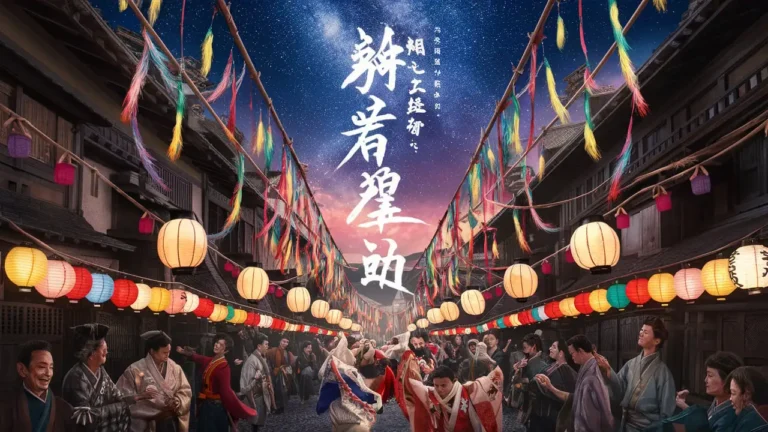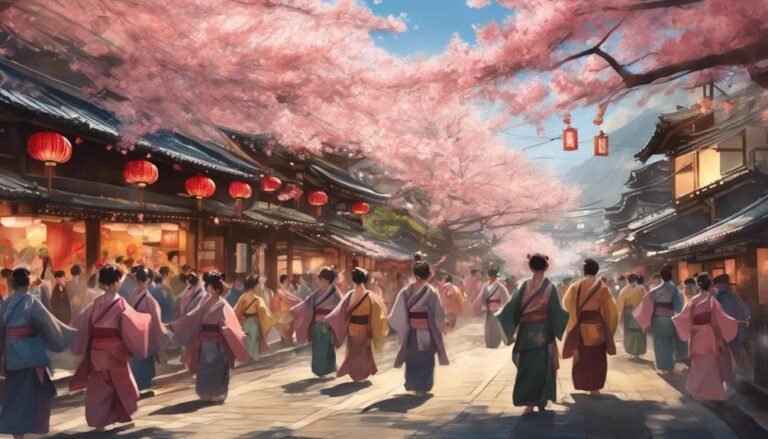Nagasaki Kunchi Japan
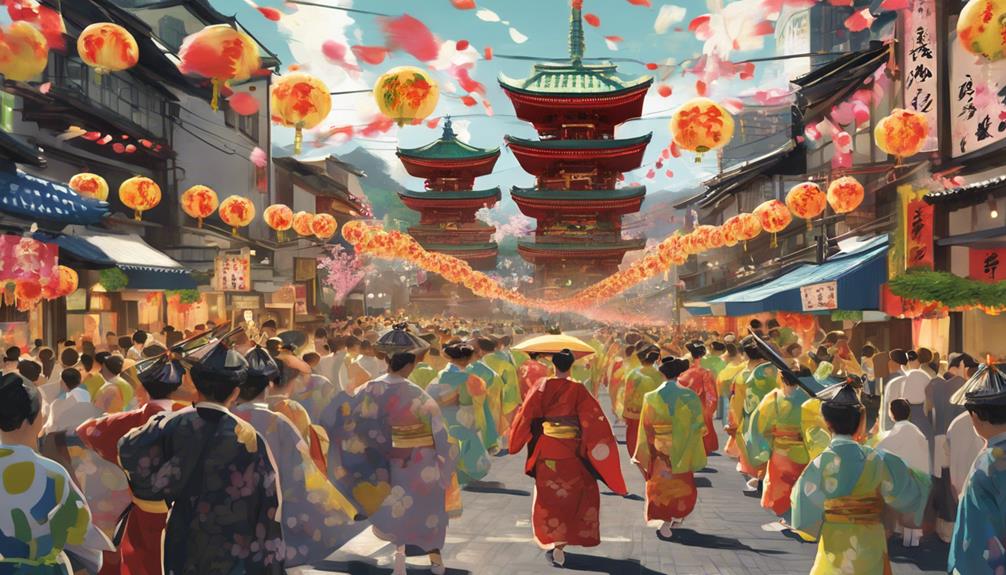
Immerse yourself in the vibrant history and cultural fusion of Nagasaki Kunchi, a renowned festival in Japan originating in the 17th century. Experience the blend of Japanese, Chinese, Dutch, and Portuguese influences, symbolizing the unity and resilience of Nagasaki. Witness traditional performances with ancient drums, dynamic dance routines, and colorful costumes reflecting deep cultural significance. Explore the unique mosaic of Japanese-Chinese influences in this festival, celebrating a rich heritage and legacy. Engage in community events, music performances, and traditional dances while relishing the diverse fabric of the festival. Uncover the wonders of Nagasaki Kunchi, a celebration like no other.
Key Takeaways
- Established in early Edo period
- Blends Japanese, Chinese, Dutch, Portuguese cultures
- Represents Nagasaki's vibrant history
- Features traditional dances, music, and costumes
- Symbolizes unity, resilience, and cultural richness
History of Nagasaki Kunchi
The evolution of Nagasaki Kunchi, a traditional festival with deep cultural roots, can be traced back to the early Edo period in Japan. Initially established in the 17th century, Nagasaki Kunchi has since undergone significant historical origins and cultural evolution, blending influences from various cultures due to Nagasaki's role as an important port city in Japan.
This festival, characterized by vibrant performances and traditional practices, showcases a unique fusion of Japanese, Chinese, Dutch, and Portuguese elements.
Over the years, Nagasaki Kunchi has transformed from a local celebration into a renowned event that attracts visitors from around the world. The festival's historical origins are steeped in the city's multicultural past, reflecting the diverse influences that have shaped Nagasaki's identity.
Through its cultural evolution, Nagasaki Kunchi has managed to preserve its traditional practices while also adapting to modern times, ensuring that its rich heritage continues to be celebrated and appreciated by both locals and tourists alike.
Cultural Significance
With its intricate blend of cultural traditions and historical influences, Nagasaki Kunchi holds a profound significance in the cultural landscape of Japan. This annual festival is a cultural celebration that encapsulates the vibrant history and diverse heritage of Nagasaki. The festival's roots date back to the Edo period, where it originated as a celebration of autumn harvests and a prayer for prosperity.
Nagasaki Kunchi is renowned for its festive atmosphere, drawing locals and tourists alike to witness the colorful parades, traditional music, and dynamic dances that are performed throughout the city. The festival serves as a platform for communities to come together, showcasing their unique customs and practices.
The cultural celebration of Nagasaki Kunchi symbolizes unity and resilience, reflecting the city's ability to preserve its traditions despite historical adversities. Through this annual event, participants and spectators alike are enveloped in a rich array of cultural expressions, fostering a deeper appreciation for Japan's cultural heritage and the enduring spirit of its people.
Traditional Performances
Discovering the core of Nagasaki Kunchi reveals a mesmerizing array of traditional performances that demonstrate the cultural richness and artistic skill of the region. During the festival, you'll be captivated by the following:
- Musical Performances: The rhythmic beats of traditional drums resonate through the air, setting the tone for the vibrant performances that follow.
- Dance Routines: Dancers clad in colorful attire move gracefully, interpreting stories of folklore and history through intricate movements that have been passed down through generations.
- Traditional Instruments: The melodies of ancient flutes and string instruments blend harmoniously with the energetic dances, creating a sensory experience that transports you back in time.
- Elaborate Choreography: Every step, every gesture is meticulously planned and executed, showcasing the precision and dedication of the performers who train tirelessly to perfect each routine.
These performances not only entertain but also serve as a living evidence to the heritage and legacy of Nagasaki, preserving the traditions that have defined the region for centuries.
Colorful Costumes
You'll be fascinated by the vibrant traditional attire worn during the Nagasaki Kunchi festival, each costume intricately designed to reflect Japan's rich cultural heritage.
The elaborate historical garbs worn by the performers hold deep significance, showcasing centuries-old traditions and stories.
These colorful costumes not only add to the visual spectacle but also serve as a powerful representation of the festival's cultural importance and historical roots.
Vibrant Traditional Attire
Adorning the streets of Nagasaki Kunchi, Japan, during the festival are vibrant traditional attire, showcasing a diverse array of colors and intricate designs that reflect the rich cultural heritage of the region. The traditional textiles aren't just garments but cultural artifacts that have withstood the test of time, embodying a deep-rooted history.
Here's a glimpse into the world of vibrant traditional attire at Nagasaki Kunchi:
- Kimonos: These elegant silk robes, often passed down through generations, are meticulously crafted and represent a fusion of traditional textiles and modern adaptations.
- Haori Jackets: These intricately embroidered jackets serve as a symbol of cultural preservation, blending ancient designs with contemporary styles.
- Obis: The vibrant sashes worn with kimonos showcase the evolution of fashion, with modern interpretations coexisting alongside traditional patterns.
- Happi Coats: These colorful coats, adorned with symbolic motifs, highlight the harmonious blend of cultural heritage and fashion evolution at Nagasaki Kunchi.
Cultural Costume Designs
Colorful costumes at Nagasaki Kunchi captivate onlookers with their intricate designs and vibrant hues, showcasing a blend of tradition and contemporary flair in the festival's cultural attire. The costume craftsmanship seen at Nagasaki Kunchi reflects a deep-rooted cultural heritage, with each garment meticulously crafted to honor the festival's rich history. Design inspiration for these colorful costumes often stems from traditional motifs and symbols, which are intricately woven into the fabric, showcasing a deep connection to the festival's roots.
The theatrical flair of the costumes adds an element of excitement and grandeur to the performances, with elaborate headdresses, flowing robes, and vibrant accessories enhancing the visual spectacle. Each costume tells a story, embodying the spirit of Nagasaki Kunchi and bringing to life centuries-old traditions in a modern context.
The combination of cultural heritage and contemporary design elements creates a visually stunning display that captures the essence of Nagasaki Kunchi's vibrant cultural celebration.
Historical Garb Significance
The historical significance of the colorful costumes worn at Nagasaki Kunchi festival dates back centuries, embodying a profound connection to the cultural heritage and traditions of the event. The traditional attire donned during the festival reflects intricate details that hold deep meanings within the community. Here are some key elements that highlight the historical importance of these ceremonial clothing:
- Symbolism: Each garment worn by participants symbolizes various aspects of Japanese history, religion, and folklore, making the costumes not just visually striking but also culturally significant.
- Color Palette: The vibrant colors used in the costumes represent different emotions and virtues, adding layers of meaning to the overall visual spectacle of the festival.
- Embroidery and Fabric: The meticulous embroidery and choice of fabrics in the costumes showcase the skilled craftsmanship and attention to detail that have been passed down through generations.
- Evolution of Styles: Over the years, the styles of the costumes have evolved, mirroring the changing trends in Japanese fashion while still maintaining a connection to the traditional roots of the festival.
Japanese-Chinese Influences
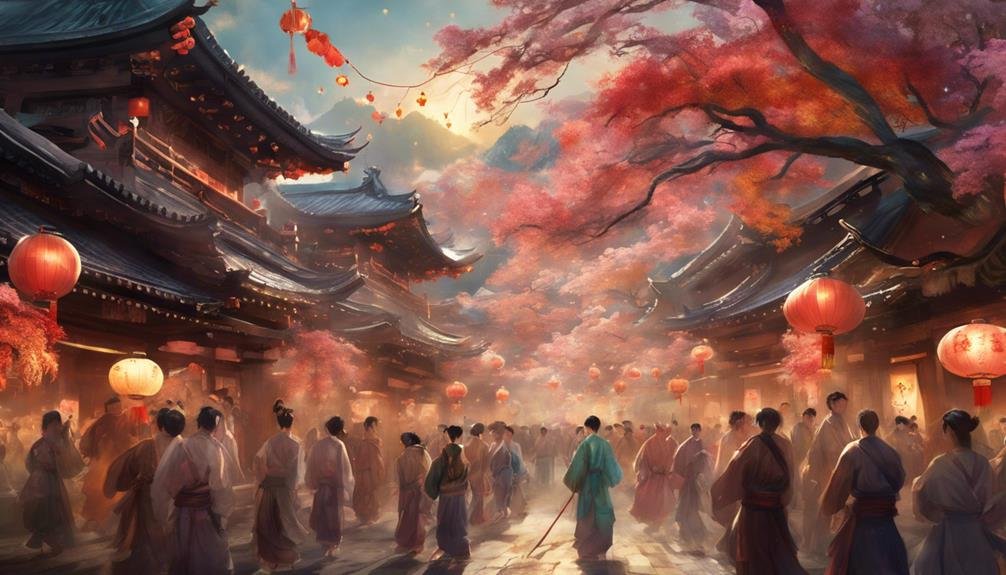
As you explore the Nagasaki Kunchi festival, you'll notice the vibrant cultural fusion that highlights both Japanese and Chinese influences.
The artistic traditions blend seamlessly, creating a unique mosaic of performances and rituals.
Symbolism plays a significant role in the intricate dances and ceremonies, adding depth and meaning to the celebration.
Cultural Fusion Highlights
Frequently intertwining elements of both Japanese and Chinese cultures are distinctly evident in the vibrant performances and traditional practices of Nagasaki Kunchi. This fusion of influences creates a unique mosaic of cultural exchange and artistic expressions.
Here are some key highlights that showcase this harmonious blend:
- Traditional Dances: The traditional dances performed during Nagasaki Kunchi often feature movements and choreography that draw inspiration from both Japanese and Chinese dance styles. The graceful gestures and intricate footwork reflect the fusion of these two rich cultural traditions.
- Modern Influences: Despite being deeply rooted in tradition, Nagasaki Kunchi also incorporates modern influences to appeal to contemporary audiences. This can be seen in the incorporation of modern music, costumes, and presentation styles that add a fresh twist to the classical performances.
- Costumes and Props: The costumes and props used in Nagasaki Kunchi performances often combine elements of Japanese and Chinese design aesthetics. Intricately embroidered garments, elaborate headdresses, and symbolic props all contribute to the visual spectacle that's Nagasaki Kunchi.
- Musical Fusion: The music accompanying Nagasaki Kunchi performances seamlessly blends traditional Japanese instruments like taiko drums with Chinese musical elements, creating a melodic fusion that enhances the overall cultural experience.
Artistic Traditions Blend
Highlighting the nuanced blend of artistic traditions influenced by both Japanese and Chinese cultures, Nagasaki Kunchi showcases a vibrant mosaic of creative expressions that captivate audiences with its cultural fusion. This unique amalgamation is evident in the traditional dances and artistic performances that are an integral part of the festival. The influence of Chinese culture on Nagasaki Kunchi can be seen in the intricate movements and costumes of the performers, reflecting the historical connections between Japan and China.
To further illustrate this blend of traditions, the table below breaks down the key elements of Japanese and Chinese influences on the artistic expressions at Nagasaki Kunchi:
| Aspect | Japanese Influence | Chinese Influence |
|---|---|---|
| Traditional Dances | Incorporation of Kabuki elements, rhythmic movements | Influence of Chinese opera, graceful choreography |
| Artistic Performances | Use of Taiko drums, colorful costumes | Presence of lion dances, martial arts demonstrations |
Through this seamless integration of Japanese and Chinese artistic elements, Nagasaki Kunchi creates a mesmerizing spectacle that celebrates the rich cultural heritage of both nations.
Symbolism in Rituals
The symbolism embedded in the rituals of Nagasaki Kunchi reflects a harmonious blend of Japanese and Chinese influences, enriching the cultural fabric of the festival. This fusion is evident in various aspects of the traditional practices:
- Dragon Dance: The dragon, a symbol of power and prosperity in Chinese culture, intertwines with the Japanese belief in dragons as benevolent beings. This dance represents harmony between the two cultural backgrounds.
- Lion Dance: The lion, a symbol of courage and protection in both Japanese and Chinese traditions, showcases unity and strength through synchronized movements and vibrant costumes.
- Cherry Blossoms: These delicate flowers symbolize the ephemeral nature of life in Japanese culture, while in Chinese tradition, they represent feminine beauty and love. The incorporation of cherry blossoms in the rituals adds a layer of depth and beauty.
- Fan Dance: Originating from Chinese classical dances, the fan dance is a graceful and intricate performance that symbolizes elegance and refinement, capturing the essence of both cultures.
Community Participation
Engage actively in the Nagasaki Kunchi festival by participating in various community events and traditions that showcase the rich cultural heritage of Japan. Volunteer involvement plays an important role in the success of the festival, providing an opportunity for locals and visitors to interact and contribute to the festivities. This volunteer engagement fosters cultural exchange, allowing individuals to fully experience the vibrant traditions of Nagasaki.
| Activities | Description |
|---|---|
| Taiko Drum Performances | Experience the exhilarating beats of traditional Japanese drumming. |
| Mikoshi Parades | Join in the lively processions carrying portable shrines through the streets of Nagasaki. |
| Dance Workshops | Learn intricate dance routines that have been passed down through generations in Japan. |
The Nagasaki Kunchi festival celebrates the fusion of local traditions with global participation. By actively taking part in these community activities, you not only enrich your own cultural understanding but also contribute to the vibrant fabric of this renowned Japanese festival.
Festival Highlights
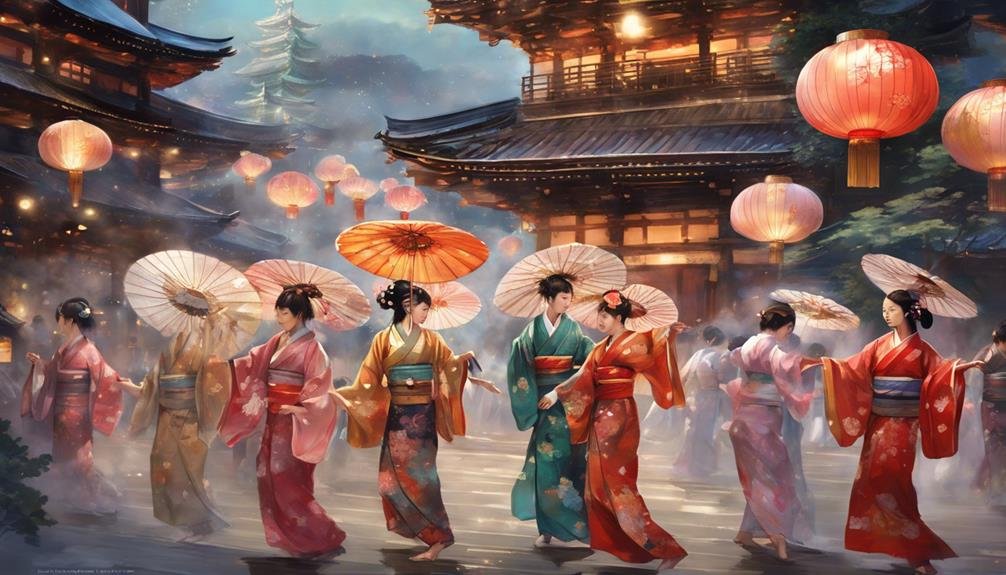
Explore the lively mosaic of Nagasaki Kunchi festival through its diverse array of cultural showcases and performances. The festival's highlights offer a vibrant array of experiences that engage you in the heart of Japanese culture.
- Music Performances: Traditional Japanese music fills the air, transporting you back in time with the melodic tunes of ancient instruments like the shamisen and taiko drums.
- Traditional Dances: Watch as performers clad in intricate costumes gracefully move to the rhythm of the music, telling stories of folklore and tradition through their elegant movements.
- Food Vendors: Indulge in a culinary adventure as you sample a variety of local delicacies, from savory takoyaki to sweet dorayaki, served fresh by friendly vendors excited to share their flavors with you.
- Cultural Workshops: Engage in hands-on activities that allow you to learn traditional Japanese arts and crafts, from origami folding to calligraphy, under the guidance of skilled artisans who pass down their expertise with pride.
Tips for Attending
Wondering how to make the most of your experience at Nagasaki Kunchi festival? To fully engage yourself in this cultural extravaganza, start by familiarizing yourself with festival etiquette. Respectful behavior is key during the performances, so remember to observe quietly and refrain from interrupting the ceremonies. Engaging with locals and participating in the traditional dances can further enrich your cultural immersion.
When it comes to planning logistics, consider booking accommodations well in advance due to the festival's popularity. Opt for lodging close to the festival grounds to maximize your time there. Additionally, familiarize yourself with the festival schedule to make sure you don't miss out on any of the vibrant performances.
For travel tips, pack comfortable shoes as you'll be walking a lot during the festival. Stay hydrated and carry snacks to keep your energy levels up throughout the day. Lastly, be prepared for large crowds and consider arriving early to secure a good viewing spot. By following these tips, you can make the most of your Nagasaki Kunchi experience.
Frequently Asked Questions
How Long Has Nagasaki Kunchi Been Celebrated?
Celebrated for centuries, Nagasaki Kunchi is a cultural event with significant historical and traditional importance. The festival has been a cherished tradition, marking a rich heritage and showcasing vibrant cultural practices over time.
What Is the Meaning Behind the Festival's Unique Dances?
When exploring the festival's unique dances, you'll discover a rich mosaic of symbolic movements that hold deep cultural significance. Each step, gesture, and costume piece weaves together a story of tradition and heritage.
Do the Performers Make Their Own Costumes?
Yes, performers typically design their costumes for festivals. This process allows them to infuse personal creativity with cultural significance. Costume design is an essential element in showcasing tradition while reflecting individual expression during celebrations.
Are There Any Special Rituals or Ceremonies During the Festival?
During festivals, ceremonial traditions and festive rituals are essential. These special practices contribute to the cultural significance of the event. Engaging in these customs fosters community bonds and preserves heritage for generations to come.
Can Visitors Join in the Festival Activities?
Yes, visitors can fully participate in the festival activities, immersing themselves in a vibrant cultural experience. Joining in the rituals and ceremonies allows you to engage with local traditions and create lasting memories.
Conclusion
Overall, Nagasaki Kunchi is a vibrant and culturally rich festival that showcases the unique blend of Japanese and Chinese influences in Nagasaki's history.
From traditional performances to colorful costumes, the festival brings the community together in a celebration of their heritage.
Attending Nagasaki Kunchi is a must for anyone looking to experience the cultural diversity and community spirit of this historic city in Japan.
Don't miss out on this unforgettable experience!

